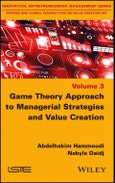Economic players must often choose between several strategic options in a fierce competitive environment where interactions with competitors make decisions particularly complex. Game theory offers useful insights to choose an optimal decision or at least a basis for making rational decision given the constraints of the stakeholders' environment. In presenting the concepts and the logical structure of the reasoning offered by game theory and their applications, the book explains the rational process of decision making in the framework of firm management and market competition. By avoiding the usual complexity of presentation often due to mathematical formalism, the book proposes a reflection and practical insights of game theory for practitioners (managers, strategists) and social, managerial and economic researchers. The book will expose both general teachings and a comprehensive analysis applied to specific case studies of various sectors of the economy.
Table of Contents
Introduction ix
Chapter 1. Game Theory and Strategic Management 1
1.1. Game theory and strategic management: semantic and/or conceptual convergences? 1
1.2. The current position of game theory in strategic management 7
1.2.1. Game theory and the school of positioning 7
1.2.2. Growing interest for game theory 13
1.3. The theoretical determinants of coopetition: borrowed from game theory 16
1.3.1. The origin of coopetition 16
1.3.2. Coopetitive practices 18
1.3.3. Mechanisms of value creation in the value network (value net) 21
1.4. Conclusion 25
Chapter 2. From Static Games to Dynamic Approaches 27
2.1. Introduction 27
2.2. Strategies and solution concepts: static games 28
2.2.1. Decentralized concepts 28
2.2.2. Maximin and Minimax solutions or the search for a new level of security 41
2.3. Process of dynamic decisions: solutions concepts 44
2.3.1. “Non-cooperative collusion” or “tacit collusion” 45
2.3.2. Sequential games 56
2.4. Conclusion 69
Chapter 3. Coalitions Formation 71
3.1. Introduction 71
3.2. The notion of a coalition and the cooperative approach 73
3.3. Emergence of cooperation: from collective rationality to individual rationality 84
3.3.1. Some illustrations 84
3.3.2. Emergence of cooperation 86
3.4. A simple conceptual frame of analysis for cooperation: notions of internal and external stability of a coalition 90
3.4.1. The concept of stability as a basic property of cooperation 92
3.4.2. The stability as an equilibrium property of a game 93
3.4.3. Examples 96
3.4.4. The role of heterogeneities 99
3.4.5. R&D in a context of asymmetrical firms 103
3.5. Conclusion 105
Chapter 4. Application 1: Dieselgate 107
4.1. Introduction 107
4.2. Storytelling: for those who missed the beginning 108
4.3. Presentation of the facts and strategic reading 110
4.4. The strategic variables and the associated game 115
4.4.1. The rules of the game 116
4.4.2. Payoff 121
4.5. Game resolution and strategic analysis 123
4.5.1. Perfect equilibrium of the game where fraud is deterred 125
4.5.2. Perfect equilibrium with the firm committing fraud 128
4.6. Conclusion 134
Chapter 5. Application 2: Emergence of Food Safety Standards 137
5.1. Introduction 137
5.2. The game 140
5.3. Nash equilibrium 145
5.4. Conclusion 154
Chapter 6. Application 3: Petrol Stations 157
6.1. Introduction: price structure of a multi-store firm and fragilization of isolated competitors 157
6.2. The facts 157
6.3. Strategic management questions 161
6.4. The game 163
6.5. Price structure in the event of collusion 165
6.6. Price war threat and game equilibrium 171
6.7 Game equilibrium within a time horizon 173
6.8. Conclusion 177
Chapter 7. Application 4: HD-DVD versus Blu-ray 181
7.1. Introduction: individual strategies and collective dynamics 181
7.2. Constitution of HD-DVD and Blu-ray consortiums 182
7.3. Definition of the game 186
7.4. Numerical application 191
7.5. Conclusion 195
Conclusion 199
Appendices 203
Appendix 1 205
Appendix 2 231
Bibliography 239
Index 259








